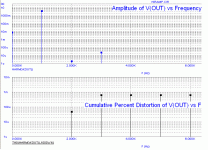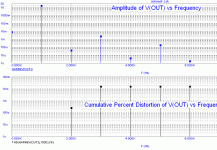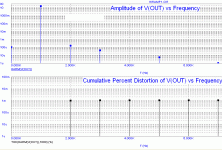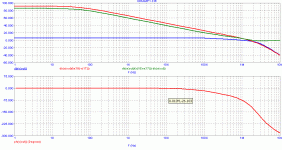john curl said:Let's try 50 ma, PMA. Anybody, (including me) can get good results at 1A.
I do not have this amp yet, it was sold. As you can see, measurements were done in December 2002. So right now I am not able to measure it at 50mA.
Anyway, the output stage was not inside global NFB. Frankly speaking, I would not like to see the result at 50mA, my imagination is working still well.
Fellow designers, let me give you my opinion of biasing. First, I don't exactly care what the bias is, so long as the voltage drop across the emitter resistors is between 10-30mV. The real problem is overheating. IF I overbias the amp so that the heatsink overheats, then the amp will thermal limit. This turns the amp off, and should not happen too often.
IF the voltage drop falls between 5mV, then I am in the class AB2 region, typical of common transistor power amps and higher order distortion will be there at almost any listening level.
IF the bias cycles between 10 and 30mV due to difficult loads, bad venting, or just plain bad luck, I don't really care, because more than 25mV may move the optimum bias off center, BUT it gives more class A region, so it probably won't be detected, since the class A region does NOT care about the value of the emitter resistor.
So I set the nominal bias between 15-22mV, and allow for the slight time lag of the thermal compensation transistors that are mounted on the heatsink NEXT TO the output devices.
For the record, this is normal. Only the new 5 pin ON power devices will speed up the thermal feedback loop with this kind of bias tracking to virtually zero time response. It is a nice characteristic, but it is not really necessary with a class AB1 power amp.
PMA, you answered your own question, you have the output stage OUTSIDE the feedback loop! Tell that to Bob Cordell and please remember, that is WHY you are NOT tempted to starve your output stage, like Bob Cordell does: 😀
IF the voltage drop falls between 5mV, then I am in the class AB2 region, typical of common transistor power amps and higher order distortion will be there at almost any listening level.
IF the bias cycles between 10 and 30mV due to difficult loads, bad venting, or just plain bad luck, I don't really care, because more than 25mV may move the optimum bias off center, BUT it gives more class A region, so it probably won't be detected, since the class A region does NOT care about the value of the emitter resistor.
So I set the nominal bias between 15-22mV, and allow for the slight time lag of the thermal compensation transistors that are mounted on the heatsink NEXT TO the output devices.
For the record, this is normal. Only the new 5 pin ON power devices will speed up the thermal feedback loop with this kind of bias tracking to virtually zero time response. It is a nice characteristic, but it is not really necessary with a class AB1 power amp.
PMA, you answered your own question, you have the output stage OUTSIDE the feedback loop! Tell that to Bob Cordell and please remember, that is WHY you are NOT tempted to starve your output stage, like Bob Cordell does: 😀
john curl said:
PMA, you answered your own question, you have the output stage OUTSIDE the feedback loop!
I made both versions, with output stage inside and outside global NFB (same bias). Then made several A-B tests with small audience. The listeners seemed to separate like 60% : 40% for outside NFB version. This depended on kind of preferred music. Anyway, people who liked club jazz and similar music preferred outside NFB version 😉 (more "rich"). Those who listened philharmony preferred inside NFB version (more "accurate"). That is like it is 😉
PMA, you are confusing the issue. You protest when I say that negative feedback gives one extra confidence that the distortion will not be audible, because it measures so low, and THEN you talk about an amp WITHOUT overall global feedback on the output stage. No wonder you like to operate at 1A, good for you. I use 1.35A myself, and I have used up to 2 amps in some designs. Heatsink is the true limit, for me.
However, Bob uses .15A in his power amp, 1/9 what I use, 1/6 of what you use, yet I have not seen him want to move it up. Why? Could it be that his distortion looks low enough for him, and why bother? Who needs class A anyway? I know that I do, but that is my preference.
However, Bob uses .15A in his power amp, 1/9 what I use, 1/6 of what you use, yet I have not seen him want to move it up. Why? Could it be that his distortion looks low enough for him, and why bother? Who needs class A anyway? I know that I do, but that is my preference.
john curl said:......................
Could it be that his distortion looks low enough for him, and why bother? Who needs class A anyway? I know that I do, but that is my preference.
Besides that is the issue how we interpret distortion at the listening level. Some amps have quite high levels but the harmonics drop off very quickly going up in frequency and some have quite low levels but the harmonics extend to far above the audio band. Here we are talking about psycho-acoustics and has by itself not so much to do with feedback mechanisms inside amplifiers.
On the other hand you can design amps either way.
Cheers 😉
It depends on where the distortion goes. Does it go away, or is it translated into dynamic phase shift? Does it alter another dimension? Who knows? I'm for class A, low or no feedback with high as possible open loop bandwidth, from my direct experience. I realize many of you will think me crazy, but I will have the last laugh! Just wait.
This thread distincly proves that a high degree of feedback is advantageous despite the opinions of some - 53 posts in less than 24 hours!
Bob,
At what output did you do your analysis, and what would have been the max. output, if more than the former? I think it is important to know where in the scope of an amplifier test results lie.
Generally,
Useful debate has been raised regarding cross-over distortion and optimal (low) bias current. Let me ask a "reverse" question. We all agree about class A - or do we .... The graph set I have shown in my post #1274 is one of many taken at the time. I could not really find a good reason to use class A, apart from the disadvantage of heat dissipation. The results shown was for a power transistor bias current of 100 mA. Going down to 70 mA I could not detect a worthwhile deterioration in harmonic structure (yes, also at 1W output, and without global NFB). So why would I need to dissipate extra heat for no advantage? As Douglas Self said, it is gratifying in the spectrum analysis to watch cross-over generated harmonics sink into the noise floor (or go below the threshold-of-audibility).
We could go spec. chasing (and there is gratification in that, especially for perfectionists - I am often one of the sinners) but I also find satisfaction in designing, in Self's terms, a "blameless amplifier", knowing that I did not waste the client's money.
Something that was not raised thusfar (pardon if overlooked) is the effect of spread in component (particularly transistor) parameters. This I did find to have an effect, to which one can make a design as insensitive as possible, at least with simulation.
Bob,
At what output did you do your analysis, and what would have been the max. output, if more than the former? I think it is important to know where in the scope of an amplifier test results lie.
Generally,
Useful debate has been raised regarding cross-over distortion and optimal (low) bias current. Let me ask a "reverse" question. We all agree about class A - or do we .... The graph set I have shown in my post #1274 is one of many taken at the time. I could not really find a good reason to use class A, apart from the disadvantage of heat dissipation. The results shown was for a power transistor bias current of 100 mA. Going down to 70 mA I could not detect a worthwhile deterioration in harmonic structure (yes, also at 1W output, and without global NFB). So why would I need to dissipate extra heat for no advantage? As Douglas Self said, it is gratifying in the spectrum analysis to watch cross-over generated harmonics sink into the noise floor (or go below the threshold-of-audibility).
We could go spec. chasing (and there is gratification in that, especially for perfectionists - I am often one of the sinners) but I also find satisfaction in designing, in Self's terms, a "blameless amplifier", knowing that I did not waste the client's money.
Something that was not raised thusfar (pardon if overlooked) is the effect of spread in component (particularly transistor) parameters. This I did find to have an effect, to which one can make a design as insensitive as possible, at least with simulation.
Mr. Curl,
Sometime ago I consult with a technician from a power amp manufacturer about one of their amps. The amp itself has RE on each bipolar output transistor, so I can measure the drop of each RE.
But for setting bias, the technican said it is "better" to measure the whole bias (in the rail fuse) than to measure voltage drop on each RE (this will measure the bias of the whole output stage instead of each transistor). And he gives me the total bias value range for that amp.
Is it better to see the whole output stage as one (how much mA the whole output will consume) or it is better to measure each drop on RE for bias setting?
Sometime ago I consult with a technician from a power amp manufacturer about one of their amps. The amp itself has RE on each bipolar output transistor, so I can measure the drop of each RE.
But for setting bias, the technican said it is "better" to measure the whole bias (in the rail fuse) than to measure voltage drop on each RE (this will measure the bias of the whole output stage instead of each transistor). And he gives me the total bias value range for that amp.
Is it better to see the whole output stage as one (how much mA the whole output will consume) or it is better to measure each drop on RE for bias setting?
john curl said:PMA, you are confusing the issue. You protest when I say that negative feedback gives one extra confidence that the distortion will not be audible, because it measures so low, and THEN you talk about an amp WITHOUT overall global feedback on the output stage. No wonder you like to operate at 1A, good for you. I use 1.35A myself, and I have used up to 2 amps in some designs. Heatsink is the true limit, for me.
I do not think so. I spoke about my amplifier with high bias (BTW I operated it up to 1.35A, and as you say, heatsink is the true limit) and wanted to show spectra for low power/class A and after transition to AB. I agree with you that low watts count.
On the other hand, I do not see the global feedback as an evil, I think that it is a very useful engineering tool and that it is a must for a conventional design with lower bias. Is it clear now?
Also, for a conventional design, I see error correction in the output stage as a good solution.
Do not get me wrong when I am saying "conventional design". Not everyone wants to run an amplifier at 100W - 200W iddle power with all that emitted heat, so it makes sense to try to find another approach.
PMA I USE global negative feedback in all my power amplifier designs. What is your point? That high bias and negative feedback are OK? That low bias and negative feedback are OK? That just about anything that anyone wants to build is OK? OK, then! 😀
john curl said:PMA I USE global negative feedback in all my power amplifier designs. What is your point? That high bias and negative feedback are OK? That low bias and negative feedback are OK? That just about anything that anyone wants to build is OK? OK, then! 😀
I do not know why you are so offensive.
High bias and NFB are OK and it depends on listener taste if he prefers high bias output stage inside or outside "global" NFB. The simple switch for both options would be the best solution, IMHO.
Low bias + NFB is sonically worse than high bias. For low bias, overall NFB is a must. It can be improved by error correction. Tried and built. This is my point.
There are thousands of amplifier designs. Some are good, some are just OK, and some are better. I don't know how I can improve on that.
Re: High biased non-NFB output stage
Yesterday I showed my 5 years old results on a real-life amplifier. I have just played with this circuit in MC8 and I am quite impressed by the similarity of measured and simulated results. Please see simulated result for 1W and compare with the measured one:
PMA said:Colleagues fellowdesigners,
I would like to share with you measurements made on my real-life power amplifier. High biased, non-global NFB, local NFB CFP diamond buffer based output stage, biased at 1A.
the 1st image is for 1W/8ohm, pure class A
http://web.telecom.cz/macura/pma1_1w_8o.gif
the 2nd is for 17W/8ohm, just after transition to AB
http://web.telecom.cz/macura/pma1_17w_8o.gif
Not bad results, are they?
P.S. Noise raise at higher freq. is converter noise shaping, not amplifier noise.
Yesterday I showed my 5 years old results on a real-life amplifier. I have just played with this circuit in MC8 and I am quite impressed by the similarity of measured and simulated results. Please see simulated result for 1W and compare with the measured one:
Attachments
Originally posted by john curl [/i]
It depends on where the distortion goes. Does it go away, or is it translated into dynamic phase shift? Does it alter another dimension? Who knows? I'm for class A, low or no feedback with high as possible open loop bandwidth, from my direct experience. I realize many of you will think me crazy, but I will have the last laugh! Just wait.
Hi John,
I’m on the same track and prefer class-A amps. But that changed a bit when I listened to the Hypex UcD class-D amps. These amps have by its nature huge amounts of feedback. Yet they come close to the “transparent” sound of a good class-A which surprises me pleasantly.
Amps without feedback doesn’t exist. Even a SET without global feedback has a huge amount of feedback inside the triode bulb: The anode-cathode interaction. Property of that feedback is that it is damn fast.
The discussion about the merits of feedback in audio amplifiers is as old as these amps are around. Baxandall and others gave a good starting point but it is by far not the end. For me the question if feedback is “good” or “bad” is no issue at all because it is always existent. It is how it is dealt with in the total design.
Still curious about a closed description in general of the intricacies of feedback on audio signals 🙂
Creers
I learn alot from NP (many from his bread crumbs 😀). In practical amp construction, the question of feedback/no-feedback can be answered after the more important question is answered, that is how good/not good is your output stage. Modifying the front stage (single differential, complementary differential, folded cascode, current feedback loop, opamp front end, various VAS configuration, etc), don't do much to alter the sound. It is the output stage quality that matters. NP even makes audio amp that the whole CCT is actually an output stage configuration, not using front end (voltage swing amplifier), and sounds good 😀
- Home
- Amplifiers
- Solid State
- Bob Cordell Interview: Negative Feedback



